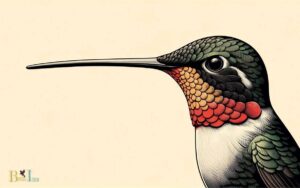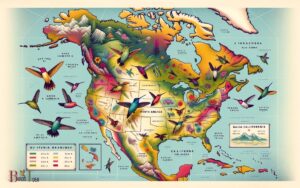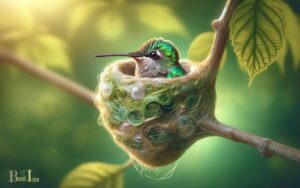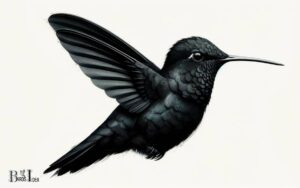Lifespan of Ruby Throated Hummingbird: 5 Years!
The lifespan of a Ruby-throated Hummingbird on average is 3 to 5 years. However, once they survive their first year, their chances of living longer increase significantly. The oldest known Ruby-throated Hummingbird was 9 years old.
Ruby-throated Hummingbirds (Archilochus colubris), like many small birds, face numerous challenges that affect their lifespan.
Predation, harsh weather conditions, and lack of food sources are common threats that can lead to a high mortality rate, especially in their first year of life.
However, those that do survive past their initial year have adapted to avoid predators and have learned efficient foraging techniques, which can extend their lifespan.
Banding studies have helped determine the age of these birds, with the longevity record for a banded Ruby-throated Hummingbird being 9 years and 1 month.
Here are some factors affecting their lifespan:
Ruby-throated Hummingbirds exhibit remarkable resiliency, and those that weather the trials of their first year can grace our gardens for several seasons to come.
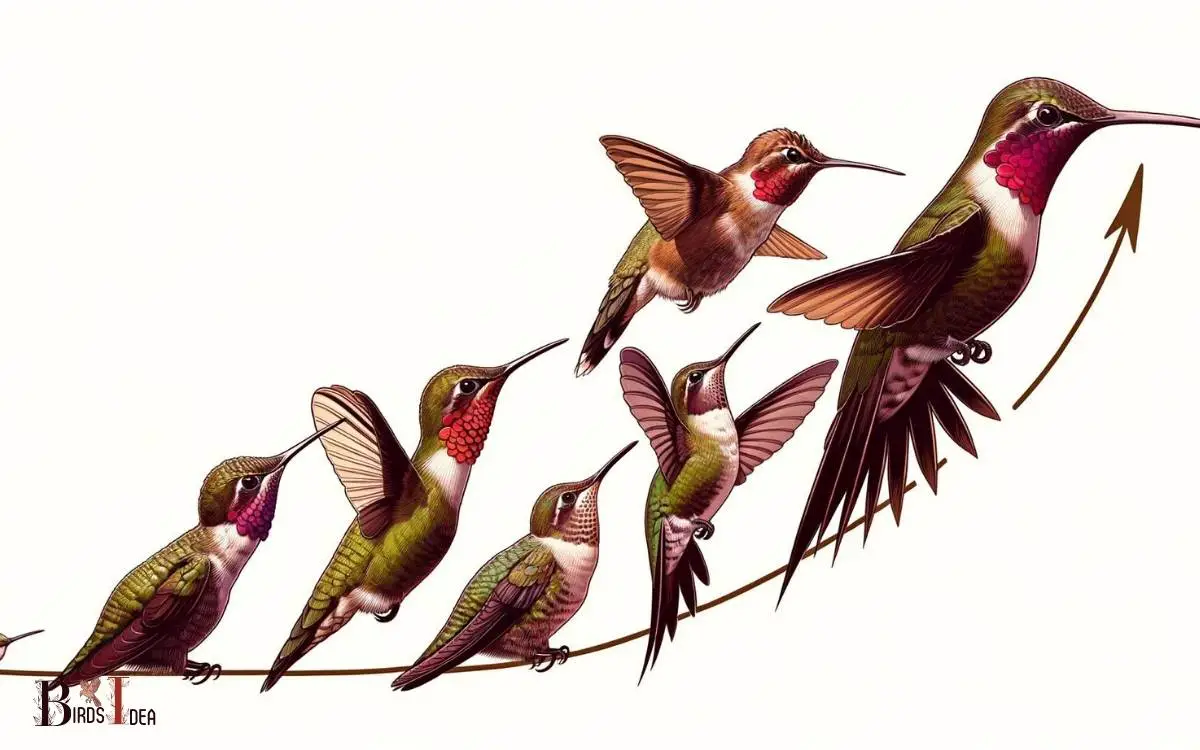
Key Takeaway
Habitat and Range
The Ruby Throated Hummingbird inhabits a diverse range of habitats, spanning from deciduous forests to meadows and gardens across North America.
These agile birds are commonly found in woodland areas, along streams, and in parks with abundant flowering plants.
They are known for their adaptability, often seen in urban and suburban settings where nectar-producing flowers are present.
The availability of flowering plants is crucial for their survival, as they heavily rely on nectar for sustenance.
The Ruby Throated Hummingbird’s ability to thrive in various habitats is a testament to its resilience and flexibility in the face of changing environments.
Understanding their habitat preferences is essential for conservation efforts and ensuring the continued presence of these remarkable birds in our ecosystems.
This diverse range of habitats directly impacts the diet and nutrition of the Ruby Throated Hummingbird.
Diet and Nutrition
With a diet primarily consisting of nectar and insects, the Ruby Throated Hummingbird maintains its nutritional needs through a diverse array of natural food sources.
The high energy demands of these birds are met through the consumption of flower nectar, which provides essential sugars for fuel, and insects, which are rich in protein and other nutrients.
The following table provides an overview of the typical diet of the Ruby Throated Hummingbird:
| Diet Component | Percentage of Diet |
|---|---|
| Nectar | 70% |
| Insects | 30% |
| Pollen | Occasional |
| Sap | Occasional |
This diet ensures that the hummingbird receives the necessary energy and nutrients for its high metabolic rate and active lifestyle.
By foraging for these food sources, the Ruby Throated Hummingbird is able to maintain its health and vitality.
Reproduction and Nesting
A female Ruby Throated Hummingbird typically lays two eggs in a small, cup-shaped nest made of plant fibers and spider silk.
The female is solely responsible for nest construction, which takes about 6-10 days to complete.
The nest is usually located on a downward-sloping tree branch, often situated over water to provide protection from predators.
The eggs are the size of navy beans and are incubated for about 12-16 days. Once hatched, the mother cares for the chicks, feeding them with regurgitated nectar and insects.
The young birds fledge about 18-22 days after hatching. Ruby Throated Hummingbirds may raise 1-2 broods per breeding season.
Understanding the intricate nesting and reproductive behaviors of these hummingbirds is essential for conservation efforts and maintaining their population.
Predators and Threats
In the habitat of the Ruby Throated Hummingbird, predators and threats pose significant challenges to the survival of this delicate species.
Predation is a major threat to these tiny birds, with common predators including snakes, larger birds, and domestic cats.
Nest predation is particularly impactful, with eggs and nestlings being vulnerable to predation by various animals.
Additionally, habitat loss due to human activities such as deforestation, urbanization, and agriculture encroachment further threatens the hummingbird’s survival.
Climate change also poses a significant threat, affecting the availability of nectar and insects, disrupting migration patterns, and impacting the timing of breeding seasons.
Conservation efforts play a crucial role in mitigating these threats, including the protection of natural habitats, the implementation of bird-friendly practices, and raising awareness about the importance of preserving the Ruby Throated Hummingbird’s ecosystem.
Migration Patterns
The migration patterns of the Ruby Throated Hummingbird are a fascinating aspect of its life cycle. Seasonal route changes, influenced by environmental factors, play a crucial role in the hummingbird’s migration.
Understanding the breeding and wintering grounds of these birds provides valuable insight into their behavior and survival strategies.
Seasonal Route Changes
Seasonal route changes of the Ruby Throated Hummingbird are driven by a combination of environmental cues and innate biological factors.
As the seasons shift, these tiny birds embark on remarkable migratory journeys, traveling up to 500 miles non-stop across the Gulf of Mexico.
The timing of their departure is primarily influenced by hormonal changes triggered by the changing day length.
Environmental factors such as food availability and weather conditions also play a crucial role in shaping their migration patterns.
During their migration, they can alter their routes based on wind patterns and food availability.
Recent studies have also suggested that individual experience and social interactions within the population can affect their route choices.
Understanding the intricacies of these seasonal route changes is crucial for the conservation and preservation of this remarkable species.
Environmental Impact on Migration
Driven by a combination of environmental cues and innate biological factors, the Ruby Throated Hummingbird’s migration patterns are influenced by a variety of environmental impacts, including food availability, weather conditions, and wind patterns.
The availability of nectar-rich flowers plays a crucial role in determining the birds’ migratory routes, as they rely heavily on these food sources to fuel their long-distance flights.
Weather conditions, such as wind patterns and temperature changes, also significantly impact their migration, influencing the timing and duration of their journeys.
Additionally, the availability of suitable stopover habitats along their migratory routes is essential for resting and refueling.
Understanding the environmental factors that influence the migration patterns of Ruby Throated Hummingbirds is vital for conservation efforts and ensuring their continued survival.
Breeding and Wintering Grounds
Annually, Ruby Throated Hummingbirds migrate to their breeding grounds in North America and their wintering grounds in Central America.
The breeding grounds are primarily located in eastern North America, spanning from southern Canada to the Gulf of Mexico. Here, the birds establish territories and build cup-shaped nests in trees or shrubs.
The wintering grounds are in Central America, primarily in Mexico and parts of Central America, where the birds find suitable habitats with abundant nectar sources.
The migration patterns are driven by environmental cues such as day length and food availability.
During migration, these birds cross the Gulf of Mexico, a non-stop flight of up to 500 miles. Understanding these migration patterns is crucial for conservation efforts and maintaining healthy populations.
Longevity and Aging
The longevity and aging of the Ruby Throated Hummingbird are important factors in understanding its life cycle and ecological impact. Ruby-throated hummingbirds have a relatively short lifespan, with the average being 3-5 years.
However, the oldest known banded Ruby-throated Hummingbird was over 9 years old. Aging in hummingbirds is challenging to study due to their small size and high mobility.
As hummingbirds age, their feathers may become worn, but this does not significantly impact their flight ability. Longevity is influenced by various factors including predation, environmental conditions, and food availability.
Understanding the aging process and factors influencing longevity in Ruby-throated hummingbirds is crucial for conservation efforts and to gain insight into the population dynamics of this vital pollinator species.
Conservation Efforts
Conservation efforts for the Ruby Throated Hummingbird focus on preserving its habitats and addressing threats to its survival.
These efforts include:
- Habitat preservation: Protecting and restoring the diverse habitats crucial for the hummingbird’s breeding, nesting, and foraging activities.
- Addressing climate change: Supporting initiatives aimed at mitigating the impacts of climate change on the hummingbird’s migratory patterns and food sources.
- Education and outreach: Raising awareness about the importance of maintaining healthy ecosystems for the hummingbird and other wildlife, encouraging sustainable gardening practices, and minimizing pesticide use.
- Research and monitoring: Conducting studies to better understand the hummingbird’s behaviors, migration routes, and population trends to inform targeted conservation strategies.
These efforts are essential for ensuring the long-term survival of the Ruby Throated Hummingbird in its natural habitats.
Human Interaction
Human interaction with ruby-throated hummingbirds has been influenced by urbanization, leading to habitat loss and fragmentation.
Additionally, the provision of human-provided feeders has impacted the feeding behavior and distribution of these hummingbirds.
Understanding the implications of these interactions is crucial for the conservation and management of this species.
Impact of Urbanization
An increasing number of urban areas have significantly altered the habitat and behavior of Ruby Throated Hummingbirds.
This impact of urbanization on the species can be observed in the following ways:
- Habitat Fragmentation: The conversion of natural habitats into urban landscapes has fragmented the hummingbirds’ natural foraging and breeding grounds.
- Noise Pollution: Urban areas often expose hummingbirds to high levels of noise pollution, which can disrupt their communication and feeding behaviors.
- Light Pollution: Artificial lights in urban areas can disorient hummingbirds, affecting their ability to navigate and find food sources.
- Competition for Resources: Urbanization has led to increased competition for nectar and insects, which are essential food sources for the Ruby Throated Hummingbird.
This urban impact has significant implications for the species’ survival and behavior, influencing their lifespan and overall population dynamics. Understanding these effects is crucial for conservation efforts and habitat management.
Feeding From Human-Provided Feeders
The Ruby Throated Hummingbird’s interaction with human-provided feeders has become a significant aspect of its feeding behavior.
These small birds have demonstrated a remarkable ability to adapt to the presence of human-provided feeders, often relying on them as a consistent food source.
The availability of nectar from feeders has been observed to supplement the hummingbirds’ natural diet of flower nectar and small insects.
While the impact of this supplementary feeding on the overall health and behavior of the hummingbirds is still being studied, it is evident that the presence of human-provided feeders has created an interesting dynamic in the ecosystem.
Understanding the implications of this interaction is crucial for the conservation and management of the Ruby Throated Hummingbird population, particularly in urban and suburban environments.
Conclusion
The lifespan of the ruby-throated hummingbird is a testament to the resilience and adaptability of this remarkable species.
Despite facing numerous threats and challenges, the hummingbird continues to thrive and demonstrate the beauty of perseverance in the face of adversity.
Its journey through life serves as a symbol of resilience and the ability to overcome obstacles, inspiring us to appreciate and protect the delicate balance of nature.

